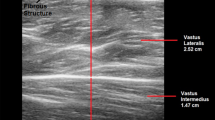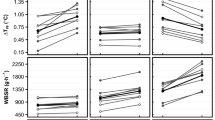Summary
Seven male volunteers were divided into two groups based on body morphology and mass. The large body mass (LM) group (n = 4) was 21.2 kg heavier and 0.32 m2 · kg −1 smaller in surface area-to-mass ratio (P< 0.05) than the small body mass (SM) group (n = 3) Both groups were similar in total body fat and regional skinfold thicknesses. All subjects were immersed to the first thoracic vertebrae for 120 min in stirred water at 18°C. Overall, tissue insulation was similar (P>0.05) between the SM and LM groups across time. Perceptual ratings of thermal sensation increased (P<0.05) across time. Therefore, as cold water immersion progressed, tissue insulation was similar and thermal sensation increased (P<0.05) in males matched for subcutaneous fat and total fat but differing in body mass and morphology.
Similar content being viewed by others
References
Bollinger A, Schlumpf M (1976) Finger blood in healthy patients of different ages and sex and in patients with primary Raynaud's Disease. Acta Chir Scand [Suppl] 465:42–47
Buskirk ER, Kollias J (1969) Total body metabolism in the cold. NJ Acad Sci Spec Symp Issue 17–25
DuBois D, DuBois EF (1916) Clinical calorimetry. X. A formula to estimate the approximate surface area if height and weight be known. Arch Intern Med 17:863–871
Epstein Y, Shapiro Y, Brill S (1983) Role of surface area-to-mass ratio and work efficiency in heat intolerance. J Appl Physiol 54:831–836
Gagge AP, Stolwijk AJ, Hardy JD (1967) Comfort and thermal sensations associated with physiological responses at various ambient temperatures. Environ Res 1:1–20
Goldman RF, Buskirk ER (1961) Body volume measurement by underwater weighing: description of a method. In: Brozek J, Henschel A (eds) Techniques for measuring body composition. Natl Acad Sci-Natl Res Council, Washington DC, pp 78–89
Hayward MG, Keatinge WR (1981) Roles of subcutaneous fat and thermoregulatory reflexes in determining ability to stabilize body temperature in water. J Physiol (Lond) 320:229–251
Hayward JS, Eckerson JD, Collis ML (1975) Thermal balance and survival time prediction of man in cold water. Can J Physiol Pharmacol 53:21–32
Hong SK, Lee CK, Kim JK, Song SH, Rennie DW (1969) Peripheral blood flow and heat flux of Korean women divers. Fed Proc 28:1143–1148
Kollias J, Bartlett L, Bergsteinova V, Skinner JS, Buskirk ER, Nicholas WC (1974) Metabolic and thermal responses of women during cooling in water. J Appl Physiol 36:577–580
Keatinge WR (1969) Survival in cold water. Blackwell, Oxford
McArdle WD, Magel JR, Gergley TJ, Spina RJ, Toner MM (1984) Thermal adjustment to cold-water exposure in restin men and women. J Appl Physiol 56:1565–1571
Rasch P, Pierson NR (1962) The relation of body surface area, mass, and indices to energy expenditure. Rev Can Biol 21:16
Rees W, Eysenck HJ (1945) A factorial study of some morphological and psychological aspects of human constitution. J Ment Sci 91:8
Sawyer M, Stone RH, Du Bois EF (1961) Further measurements of surface area of adults and children. Arch Intern Med 17:855
Shapiro Y, Pandolf KB, Avellini BA, Pimental NA, Goldman RF (1980) Physiological responses of men and women to humid and dry heat. J Appl Physiol 49:1–8
Shapiro Y, Pandolf KB, Avellini BA, Goldman RF (1981) Heat balance and transfer in men and women exercising in hot-dry and hot-wet conditions. Ergonomics 24:375–386
Siri WE (1956) Gross composition of the body. In: Lawrence JH, Tobias CA (eds) Advances in biological and medical physics, vol 4. Academic, New York, pp 239–272
Sloan REG, Keatinge WR (1973) Cooling rates of young people swimming in cold water. J Appl Physiol 35:371–375
Smith RM, Hanna JM (1975) Skinfold and resting heat loss in cold air and water temperature equivalence. J Appl Physiol 39:93–102
Toner MM, Sawka MN, Holden WL, Pandolf KB (1985) Comparison of thermal responses between rest and leg exercise in water. J Appl Physiol 59:248–253
Toner MM, Sawka MN, Foley ME, Pandolf KB (1986a) Effects of body mass and morphology on thermal responses in water. J Appl Physiol 60:521–525
Toner MM, Drolet LL, Pandolf KB (1986b) Perceptual and physiological responses during exercise in cool and cold water. Percept Mot Skills 62:211–220
Veicsteinas A, Ferretti G, Rennie DW (1982) Superficial shell insulation in resting and exercising men in cold water. J Appl Physiol 52:1557–1564
Wilmore JH, Vodax DA, Parr RB, Girandolaand RN, Billing JER (1980) Further simplification of a method for the determination of residual lung volume. Med Sci Sports 12:216–218
Author information
Authors and Affiliations
Rights and permissions
About this article
Cite this article
Glickman-Weiss, E.L., Nelson, A.G., Hearon, C.M. et al. Effects of body morphology and mass on thermal responses to cold water: revisited. Europ. J. Appl. Physiol. 66, 299–303 (1993). https://doi.org/10.1007/BF00237772
Accepted:
Issue Date:
DOI: https://doi.org/10.1007/BF00237772




